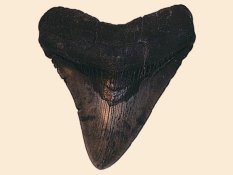
Fossilized shark teeth reveal a fresher, more isolated Palaeogene North Sea, writes Sarah Day.
Geoscientist Online, 25 August 2009
A team of German and British scientists have used fossilised shark teeth to reconstruct the climate of the North Sea during the Palaeogene period, between 40 and 60 million years ago. The results suggest that the North Sea was for a brief period isolated from surrounding oceans, resulting in surface-water freshening and a significant reduction in the diversity of life.
The Palaeogene was a time when greenhouse conditions prevailed and mammals began to diversify in the wake of the mass extinction event that saw the demise of the dinosaurs, along with 65% of all species. It also featured a brief episode of global warming known as the Palaeocene-Eocene thermal maximum (PETM), a rapid climatic disturbance that saw temperatures rise by around six degrees in a 20,000 year period.
While scientists already have a lot of information about the climate on land and in open water during the period, very little has previously been known about the climate of marginal seas like the North Sea. The researchers used oxygen isotope data obtained from shark teeth recovered from the London and Hampshire basins, as well as sites in Denmark, Belgium, the Netherlands and Sweden. They cover a 33 million year period during the Palaeocene-Eocene epochs, representing both shallow and deeper water depths.
Sharks shed thjeir teeth continually throughout their lives, qnd so are relatively abundant in the fossil record. Often they are the only part of a shark to be fossilised, with specimens from as far back as 450 million years ago having been discovered.
When the teeth grow, their oxygen isotope ratio mirrors that of the sea water in which their owners are swimming, so fossilised teeth can be used as a record of palaeo-temperature. Warmer seas contain more of the heavier isotope,
18O, as it is easier for the lighter
16O to be removed by evaporation. The isotopoes are also used to indicate the salinity of water, as the water becomes more salty with increased water evaporation.
Results indicate that the North Sea was once far less salty than it is today. For a period of between two and four million years, the ratio of
18O to
16O was a substantially lower than the average for sea waters of that period, with the value lower even than some contemporary freshwater lakes.
The period of surface water freshening began close to the PETM. At this time, around 55 million years ago, relative sea-level fall, tectonic uplift and volcanic activity meant that the North Sea was temporarily isolated from surrounding oceans. Tectonic uplift raised Western Scotland by around 2-3 km, causing a land bridge to form between the Faeroe-Shetland and Roackall basins.
With circulation between the North Sea and the North Atlantic Ocean restricted, the waters of the North Sea became significantly fresher. This freshening increased as rivers and precipitation flowed into the isolated North Sea. The result was a significant drop in the diversity of life, with the foraminifera being particularly affected.
The results of the research are published in the September issue of the
Journal of the Geological Society.